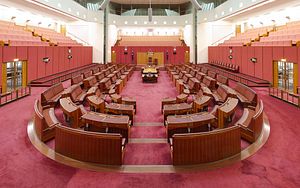Last week legislation to change the voting procedures for the Senate passed both houses of the Australian Parliament. With the current conservative Liberal/National coalition government not having a majority in the Senate, the legislation was passed with the assistance of the Greens, and the powerful South Australian Independent Senator, Nick Xenophon.
Whenever a voting system becomes a topic of debate it is guaranteed to involve a great deal of self-interest, whether it be to preserve an existing advantage, or to try and prevent a subjectively undesirable outcome.
In the current configuration of the Senate, if the opposition Labor Party and the Greens vote together to oppose legislation, the government requires the votes of 6 of the 8 “crossbenchers” — a diverse group of independents and minor parties — to pass a bill. This has proved difficult for the government to achieve.
While the Senate has always been the easier house for smaller parties to access, two recent phenomenon have converged to produce the crossbench that exists today.
Firstly, the percentage of the overall vote that has gone to the two major parties has started to fall. Down to 79 percent of the total vote at the 2013 federal election (and 73.5 percent at the 2014 Victorian State election). This discontent with the major parties has converged with smaller parties coming to the realization that if they preferenced each other in the Senate’s preferential-proportional system, instead of preferencing their prefered major party, then the chances of electing at least one of them is increased. This may not elect a party of choice, but it does allow “discontent” to be elected in the form of one or more minor parties or independents in each jurisdiction.
The public line promoted by the government is that the current voting system has been “rigged” by minor parties and therefore become “undemocratic,” The most prominent example being the election of Senator Ricky Muir of the Motoring Enthusiast Party, who was elected on just 0.51 percent of the primary vote. However, after preferences were distributed, he gained the 14.3 percent required to obtain the quota required for a seat.
It has been noted, with some irony, that as a former saw mill worker, rather than one of the lifelong political operatives who dominate the major parties, Senator Muir actually is an excellent representative of Australian society that democracy envisages.
The changes to the Senate voting system now allow voters to direct up to six preferences of their own “above the line” on the ballot paper, rather than just voting for a single party and having it direct preferences for you.
On the surface this seems like it is empowering people to direct their preference more easily (an option available “below the line,” but seldom taken on tablecloth ballot papers) and weakening the influence of party machinations. However, there is a cunning ploy here.
This change is designed to try and prevent minor parties from “harvesting” preferences in long processes where preferences bounce from minor party to minor party until a necessary quota is achieved (Senator Muir was elected after 291 rounds of preference distributions).
This, again, seems like a reasonable idea. However, experts have deduced that its true intent is an attempt to nullify the approximately 15 percent of the electorate that no longer has faith in the Liberal/National coalition, the Labor Party and/or The Greens.
The calculation is that voters will place a major party within one of their six preferences preventing the “discontent vote” from consolidating into a unified vote in each jurisdiction.
There is a potential danger in attempting to stifle discontent in such a way. There is a great importance for social stability in allowing discontent to feel like it at least has some access to public institutions.
Australia’s democracy has had a decent record of allowing non-mainstream voices significant oxygen, and the party that has benefited from this the most has been The Greens since their formation in 1992.
Having their initial seats won through preferencing, without a large primary vote, they owe their current foothold in the Parliament, and to mainstream public debate, to the previous voting system. There is a sense that the party is now pulling up the ladder behind them to prevent other parties from taking a similar route into the mainstream.
With a federal election due at the latest by November, and potentially to be called for in July, Australia will soon discover just how these voting changes affect the composition of the Parliament.
Australians will learn whether the desired outcomes of the government — to clear a legislative path — and The Greens — to prevent minor parties from eating into their status as the third force — are achieved. Or whether this political collusion just continues to increase the percentage of the public vote that rejects the major parties.

































